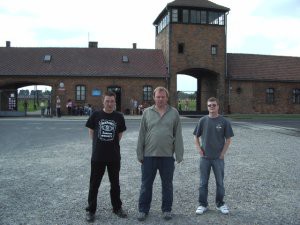 |
Ash, Paul and I head to the amazing city of Krakow in Poland.We stayed for 5 days, and had a brilliant mixture of lads nights out, seeing all the sights of a beautiful city, and visiting the Wieliczka Salt mine, and both of the Auschwitz sites. |
| We arrived at 8pm in the evening, and got a taxi to our hostel (we had decided on hostel accommodation, as it was cheap and a lads holiday, doesn’t normally require the fineries of a couple’s holiday).Never mind, we went out local, for a pint. Although a quiet out of town bar, we were given our first experience of the sheer hospitality of the people in this country.
We had fully expected it to be basic, but it was a bit more basic then we intended (had no bar, beds 2.5 feet wide, and the on-suite bathroom, wasn’t.) |
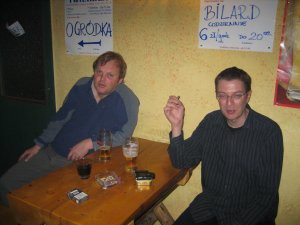 |
 |
After a fairly late night, Ash attempts to fight against nature, and get comfortable in this bed.But we weren’t there, to lie in bed, and after a quick wash, we packed our daysacks with guidebooks camera’s and all the usual hoo-ha before hitting the town centre. |
| I took the lead navigating, and on the way, we passed a traditional Krakow Tram. As we proceeded further, we hit the “Planty”.There used to be a wall, all the way around Krakow.The wall is no longer there, and is now made up of a sort of circular park, that rings the city.In reality, we had been going in the wrong direction, and heading out of town. |
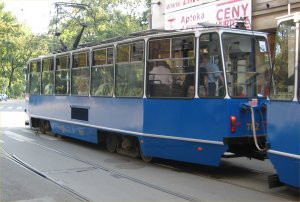 |
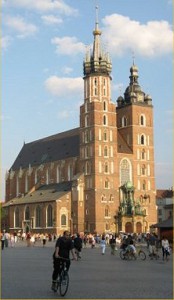 |
The Church of St Mary, in the Market Square (the largest town square in Europe).The Church is one of the few Asymmetrical Churches in existence.The left tower is the Bugle Call tower, the right is the South Bell tower. |
| Continuing our walk around the centre, we visit the famous Cloth Hall (Sukiennice) built in 1555.Around the outside of the Hall, are arcades with restaurants and shops.On Saturdays, the whole of this area would become an open air market.In the evening, tables would be put out, serving every kind of cuisine, to hundreds of people, both tourist and local alike.
Photographed from the East side, the sun really brought out the colour of the building. |
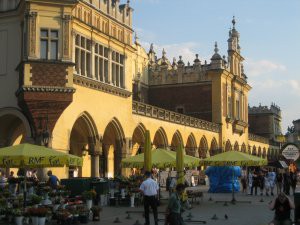 |
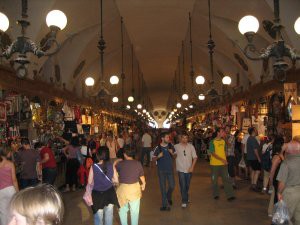 |
Inside the Cloth Hall.A vibrant market, selling just about everything you could think of, as well as cloth.It wasn’t just tourist tat either, there were a lot of locals in here, shopping for clothes, food etc which for me proved it authenticity.
I bought most of my presents in here. |
| One of the many types of environmentally friendly transport, the old favourite a horse and cart.These ran up and down the square, seemingly all day and all night.
With all the traditional buildings around, this helped to give the square an authentic feel. |
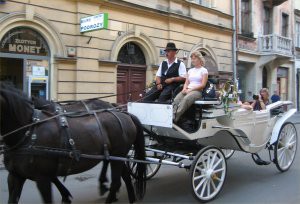 |
 |
The Church of St Anne.A traditional Baroque Church.The story goes that John of Kety (Jan Kanty) was already a saint when he died, and was put to rest in a Church on this site.To honour him further, the original church was demolished, and this building was built around his grave.Construction began in 1689.
Because it was in a small street, it was impossible to photograph the building from the front.
There is a clever architectural feature of the doorway, which gives it an enhanced 3 dimensional look, from the front. |
| There were loads of interesting buildings, all a short walk from each other, starting from the squareThe Collegium Nowodvorianum is a hidden gem within the city.
The outside walls, give no clue to the beautiful building inside.The first secular secondary school in Krakow, established in 1586 and one of the best preserved Baroque buildings in Poland. |
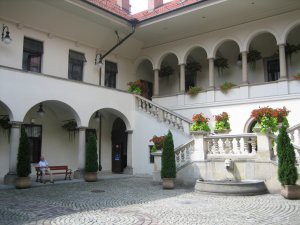 |
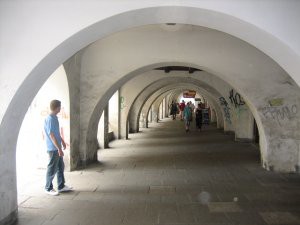 |
As we headed towards the Kazimierz quarter, I took this picture, as the arches kind of lead the eye so well.
It’s also one of many pictures I took, where Ash was walking in front of me, and I took a superb picture of the back of his head.
One other interesting thing, is the Graffiti featured on the right of the picture. It is one of the few occurrences of Graffiti I saw in an otherwise spotless city.
Equally, there were no gangs of teenagers, loitering drunks or anything like that during the whole trip, overall and extremely safe City.I realized later, that although friendly, the City is quite conservative. |
| We were passed on the way by this “vehicle”.
The “driver” steers, and passengers pedal to propel it forward.
Although it looked a bit silly, it further convinced me of the commitment to environmentally friendly transport within the city. |
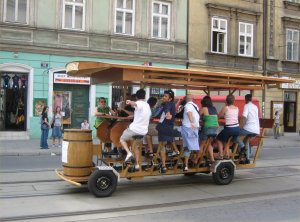 |
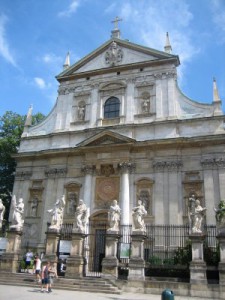 |
The Church of St Peter and St Paul.The architecture was superb.
I found Krakow everything I had hoped Prague would be. |
| Remuh Cemetery.I had originally intended to go inside, and see the wailing wall.
When I got there, it just felt wrong somehow, so I looked around outside.This wall has plaques which commemorate the deaths of peoples family members.
One of the plaques had been put up by someone who had lost 83 members of his family. |
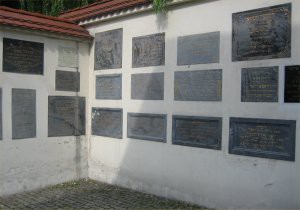 |
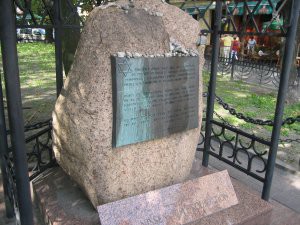 |
A monument laid by the Nissen Foundation. It commemorates the death of Polish Jews by the Nazis.
There was a small park behind it, and a series of nice bars and restaurants around the area.
I felt it was symbolic. If the victims of the holocaust had been alive, they would probably have been relaxing on a nice day like this, in one of the bars, or having a picnic in the park.
The point is commemorating tragedy and loss, can be a celebration, and needn’t be sombre. |
| On the way back, we had a few drinks in a pub in the Square.
The conversation was very contemplative. Probably because of the Jewish cemeteries we had seen, and that we knew we would be visiting Auschwitz quite soon. |
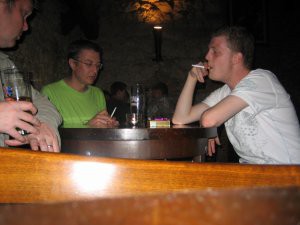 |
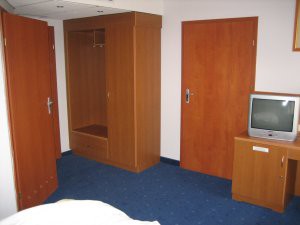 |
We continued drinking, until around 2.30am.
In process we had become separated from each other (the thing I advise friends, never to do, when travelling !).
I tried to read the guidebook, and find my way back to the hostel, but my vision was blurred.
I saw a hotel, and booked into it.
When I awoke in the morning, I had no idea where I was, then slowly the realization hit me. I found myself in the plush Alexander Hotel.
I checked out, and then walked for an hour to get back to the lads at the hostel. I found that it had taken Paul 2 hours to get home, the evening before. |
| The Royal castle at Wawel hill.
The slightly projecting section to the right of this picture, is the “Hens Claw” wing which houses a study and a collection of musical instruments. |
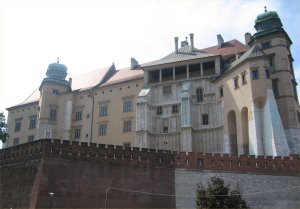 |
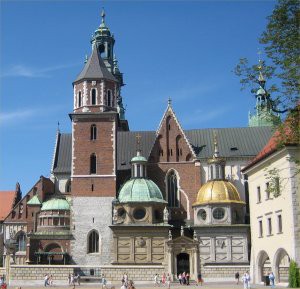 |
As we headed inside the Castle, we stopped to look at the Cathedral, the spiritual home of the nation.
One of the most popular buildings in Krakow, among the locals, it has been the scene of Royal Weddings, Coronations and funerals.
There was a cafe nearby and some nice gardens.We sat down, and had a drink, while looking at the Castle, shortly before we were attacked by wasps, and forced to leave our beverages. |
| As we walk through the main entrance to the Royal apartments, Paul is distinctive in his snot coloured t-shirt.
The castle had real charm. |
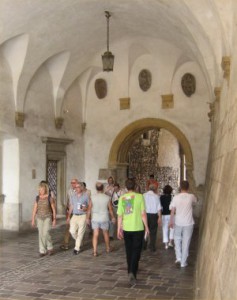 |
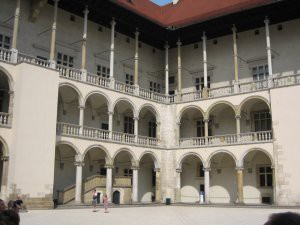 |
I took several shots of this, but could never really capture the size and opulence of the setting.
The balconies around the courtyard, must be fantastic to stand on and take in the view. |
| We left the Castle by a different route, than the one we entered, and made our way along the water front of the River Vistula.
We passed this boat, where a band were playing and had a few drinks.It was a lovely day, and everyone was having a good time
. I have never sung along to a Hammond organ before. |
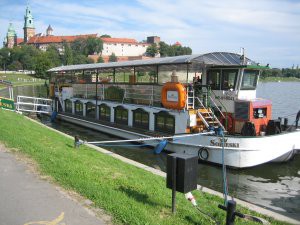 |
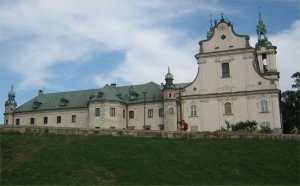 |
The Pauline Church on the Rock, has an interesting history.
In 1079 the king gave orders for his knights to kill a meddlesome bishop (similar in a sense to the English story of Thomas A’ becket).
They found the bishop and, drawing swords tried to kill him. A mysterious power repelled their blades as each man tried to strike – it was an omen to be sure.
Later the king arrived and killed him while praying. The king became cursed, and a little while later was exiled.
The martyrdom of Stanislas Szczepanow gave rise to a powerful cult which led to the late Bishop becoming the only Patron saint of both Krakow and Poland. |
| During our 3rd day in Krakow, we decided that the hostel just wasn’t for us (it was only about £10 per night, but we just couldn’t get any sleep, and the bathroom wasn’t what we expected).
We decided to go a bit upmarket. After making enquiries, we decided to stay at the 5 Star Grand Hotel.
The hotel had originally been a house built for one of the Royal princes, and had the styling to demonstrate this. |
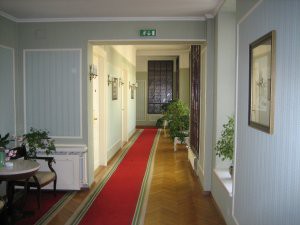 |
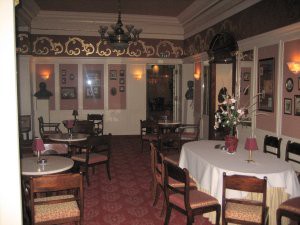 |
The dining room, where we could eat breakfast in the morning (we normally had it, in our room).
The whole place reminded me of the people in the film Titanic, and the luxury to which they were accustomed.
A luxury, which after 20 years working in computers, I can also enjoy 🙂
On one evening, we stayed up in the bar, quite late, and found out later, that the girl serving us, had worked 50 minutes past her shift, when she could have gone home.
This kind of customer service, was common in Krakow. |
| Our receptionist was not used to clientèle such as us (i.e. seemingly wealthy lunatics !), but remained professional and helpful (and at times mildly amused).
Okay, it was a bit expensive, but its one of the best hotels in the country, and well worth the investment in both our comfort, pleasure and ability to sleep without being disturbed. |
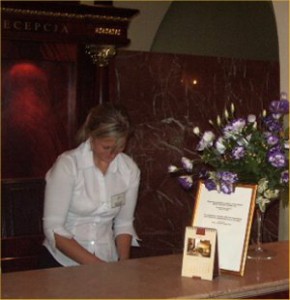 |
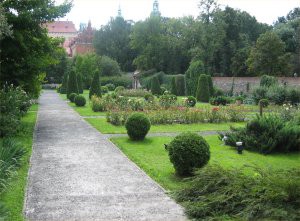 |
We visited the Archaeological museum (is there a city in the world that doesn’t have one of these ?).
The park outside was one of the nicest I have ever seen. |
| Inside, they had some really excellent exhibits, including some authentic bows and arrows (I had just returned from a bow making course, so I found that quite interesting.)
Swiatowid.
This statue represents a four faced idol holding a cornucopia.Evidence of ancient pagan cults like this, have been found around the Wawel area.
You can see what I mean about Ash, can’t you. |
 |
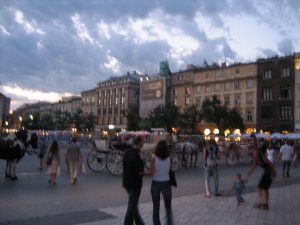 |
The Market square in the evening was full of atmosphere.We went around several of the pubs in the square.
Restaurants, serving everything from Mexican to Curry were of superb quality food. |
| This shows the inside of one of the many excellent bars we visited. Authentic, friendly and spotlessly clean.
On one afternoon, Paul and I went drinking for 3 hours, while catching up (Paul works in Brussels now).
The bill came to £10 !.The décor and atmosphere, seemed to rub of on the clientèle.
Some lads on a stag do, came in to play pool. We were all expecting the usual sillyness, but this didn’t happen.
They came over chatting, asked for recommendations for sights and venues.
They were so nice, that we actually bought the groom a drink (if I am in somewhere quiet, I would normally leave, when a stag do arrives, which I think illustrates the contrast). |
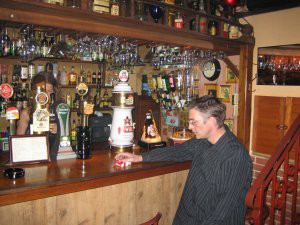 |